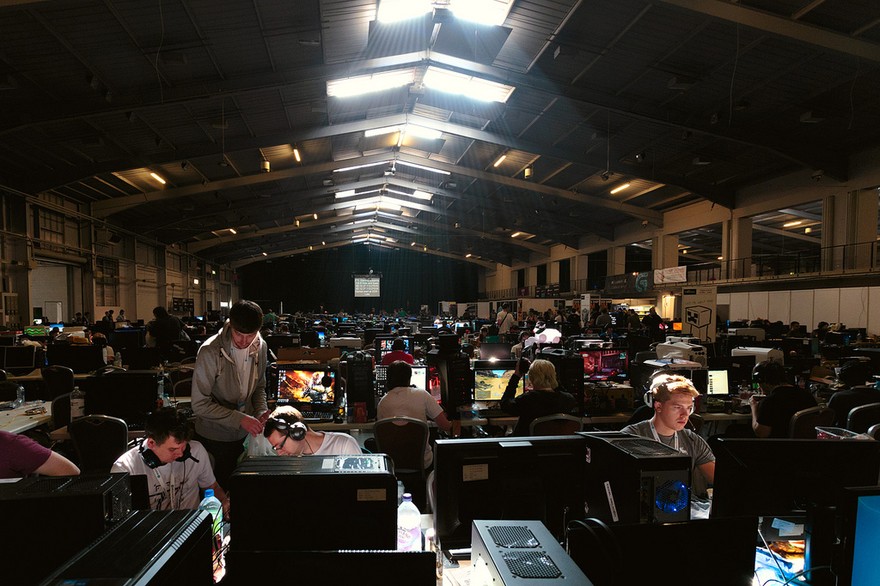This article is part of a collaboration with iQ by Intel.
For the niche gaming community of PC gamers, there is nothing as unique as the LAN party. Groups of people, sometimes hundreds, meet to play a multiplayer game in person over a Local Area Network. They abandon the anonymity of the Internet to compete face-to-face. These meetups have changed a lot over the years.
“I remember meeting in someone’s garage where everyone had these big beige towers. We begged or borrowed equipment from places we worked to be able to network everything together and it was a nightmare. Over the years, equipment became better and cheaper; technology advanced and became simpler to use. This helped the garage LAN party grow into these huge, amazing public events,” said Johnnie Rodriques, Technical Marketing Engineer at Intel.

Some of the most famous of early video games were multiplayer: Pong, Combat, or Joust. Eventually arcade games would get big machines that support 2, 4, or even 6 players. But it wasn’t until computers became connected over Internet lines that they became true multiplayer experiences. Even then, players would still get together and connect all of their PCs to a network. They would play one another in a more visceral way than gaming over phone lines could ever allow.
In today’s PC gaming community, with online multiplayer gaming as the norm, LAN parties have evolved to be all about competition. Whether you call it eSports or gaming tournaments, these parties are about the neverending pursuit of the cutting edge. But the competition isn’t just between players. In a LAN party, even PCs compete.
Players use gaming mice with a gazillion updates per second for the most pixel accurate cursors and with an outrageous amount of buttons. They use keyboards with special spring loaded keys, and game controllers with more sensitive buttons, extra paddles, and precise ergonomics to maximize the speed at which they can give commands. And that’s not to mention the actual computers themselves.
“There is little difference between ‘gaming’ and ‘LAN’ PCs anymore. You used to have to use an add-in card to networking, do special configuration to participate in a LAN party. Now, just about all of that is either built into the motherboard or the software being used. Most LAN PCs today are just gaming PCs brought from home.”
The highest echelon of PC gamers build machines that are $3000+ and truck them around to LAN parties. Picture this: you sit down in your ergonomically made leather chair and pull your mouse and keyboard close. You look at three monitors arranged like vanity mirrors, running at refresh rates faster than televisions.
They turn on computers with processors that have 4 or 6 or 8 cores, overclocked to run faster than normal. They have two or four graphics cards running together, maybe multiple hard drives in a RAID array for improved speed, the quickest and most expensive of RAM, and all sorts of high-end networking cards, motherboards, and liquid cooling systems. With such horsepower, the games are running at ridiculous speeds and the players know they are playing a game in the best possible way they can, getting every advantage for their match— or at least, not falling behind the other players with their own souped up rigs. Players show them off at these LAN parties as much as they show off their own playing skills.

“Being able to build something so you can stand out from the sea of black boxes, express your individuality and show off your skills is a major reason to mod your PC. Of course, that’s with the knowledge that the PC still has to be able to run the games and applications you need it to,” said Rodriques.
For some PC players at these huge tournament events, they aren’t showing off the power of the PC they have built, but the uniqueness or creativity. These modders want to show they have the smallest PC that will run a given game (like a NUC or a minitower), or the most colorful machine (with lights or graffiti), or the most invisible machine (inside a box on the wall), or the geekiest computer (done up as a prop from their favorite game, show, or film). They compete in these events with not only their hands, but with their discerning eye and particular taste.
Rodriques said, “For gaming PCs, I get excited when I see something new: Some new way to do wiring, or new techniques using CNC/Lasers to cut panels or making something that wasn’t a PC into a PC. Seeing modding evolve, bringing in techniques from other areas, shows me how passionate gamers can be. It’s that self-expression that is one of the reasons I continue to see a great future for gaming desktops. There’s always something new to see.”
Lead image courtesy Trammel Hudson. Body image courtesy Mr Seb. Second body image courtesy Flavio Ensiki.
